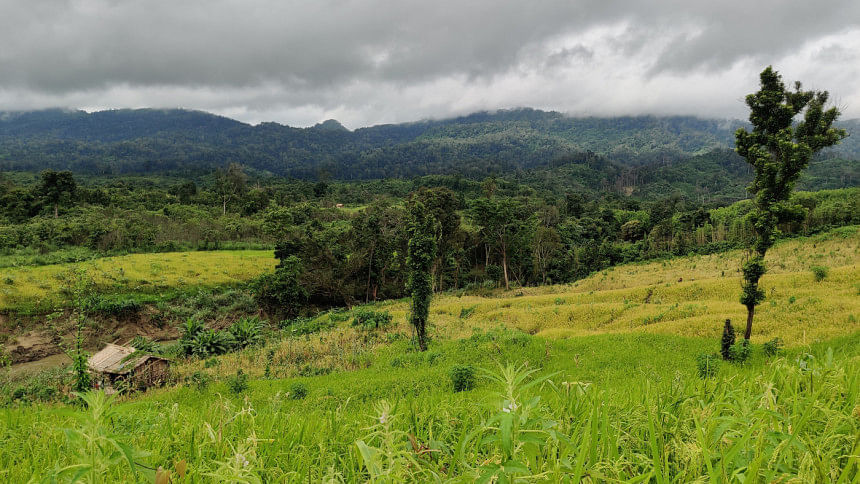Jhum taking a turn from its traditional past

Farmers in the hilly areas of Bangladesh, who practise a traditional form of cultivation known as jhum, are pleased to be getting good yields of paddy this year despite the unfavourable weather conditions.
Jhum cultivation, also known as slash and burn agriculture, entails shifting fields between harvests, with the land usually being left uncultivated for around one year so that nutrients can return to the soil.
Once a piece of land is selected for jhum cultivation, all the vegetation is cut down and dried before being burnt on the ground from which they sprang.
This process clears the field of weeds and pests while also helping the soil regain nutrients, such as potash. In addition, it enhances the growth of natural vegetation, which is essential for soil health.
Other than Bangladesh, the traditional cultivation method is practiced by indigenous communities in hilly or mountainous regions all over South Asia, including Nepal, Thailand, Indonesia and Malaysia.
In the early days, only paddy was sold in the market while up to 40 types of vegetables and fruits, such as ginger, turmeric, bitter gourd, chili, banana and okra, were grown by the farmers for their own households.
Nowadays, crops other than paddy are increasingly being cultivated for sale in the market.
Jhum cultivation has transformed over the past three decades as farmers now grow more of the various crops, said Aongkya Aong Marma, a jhum farmer in Kaptai upazila of Rangamati.
"Last year, I used jhum cultivation on about 10 acres. After the harvest, I sold 19 maunds of turmeric for Tk 7,500 per maund (around 37 kilogrammes) and six maunds of sesame for Tk 5,000 per maund," he added.
Officials of the Department of Agricultural Extension (DAE) in Khagrachari, Rangamati and Bandarban said jhum cultivation was used on about 14,000 hectares of land across the three districts this year.
Md Moniruzzaman, deputy director of the Rangamati DAE, said although paddy cultivation decreased amid the recent rains, farmers had increased the cultivation of the other crops.
Besides, jhum cultivation has helped many locals achieve financial solvency, he added.
Regarding the slump in paddy production using the method, he said they were advising jhum farmers to increase the diversity of their crops with fruits and vegetables, and also provide training and support to this end.
Generally, a piece of fertile land set to undergo jhum cultivation is cleared of natural vegetation in the February-March period before the ground is made ready with the burnt materials in the April-May period.
Farmers then begin the sowing process in the May-June period, just ahead of the monsoon season whereas harvesting takes place from September onwards.
This year though, paddy crops were planted late as incessant rains had delayed the sowing period.
Kiron Chakma, who practices jhum cultivation in Dumdumia union of Rangamati, said parts of his paddy field were affected by landsides due to the heavy rainfall last month.
"Still, I expect yields of two tonnes this year…Besides, my turmeric and ginger crops are doing fine," he added.
Similarly, Renthwai Mru, a jhum farmer in Remakri union of Bandarban, said she expects seven tonnes of paddy from her field this year even though parts of the land were recently affected by flooding.
Kalyanmoy Chakma, a jhum farmer from Panchari upazila in Khagrachari, said he has already harvested about 40 maunds of paddy so far this season.
Yangan Mru, another jhum farmer of Remakri union, said the traditional cultivation method was not just a means of making money as much of the country's culture has its roots in jhum.
"Don't think that jhum cultivation is only for securing one's livelihood as many songs, myths and stories originate from the practice," he added.
Yangan, who graduated from the University of Chittagong, decided to take up jhum cultivation rather than pursue a job as it gives him the freedom to explore his identity as a writer as well.
"I cultivated vegetables, different fruits and cotton this year. I had to cancel paddy cultivation though due to late rainfall," he said.

 For all latest news, follow The Daily Star's Google News channel.
For all latest news, follow The Daily Star's Google News channel. 





Comments